This document discusses human resource management practices in hospitality multinational enterprises operating in India. It begins with an introduction on the growth of multinational enterprises globally and their presence in emerging markets like India. It then reviews literature on factors that influence the human resource management practices adopted by foreign multinational subsidiaries operating in a host country, including pressures for standardization versus localization. The study aims to compare the HRM practices of Indian hospitality MNEs to foreign hospitality MNEs operating in India and examine how practices are influenced by firm-specific factors like nationality, size, and industry. It hypothesizes that HRM practices will remain aligned with the local cultural environment and diverge from practices in foreign MNE subsidiaries.
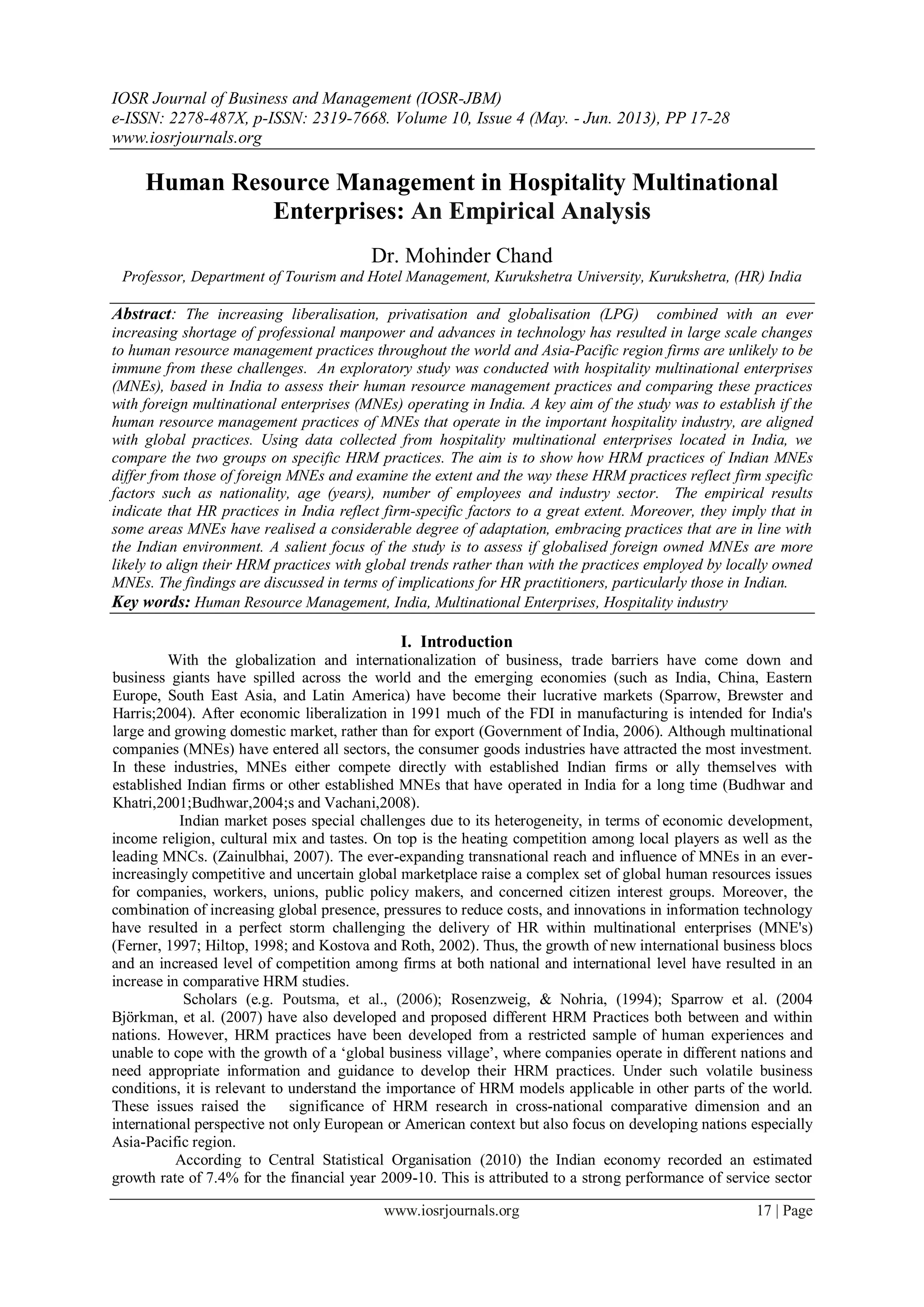
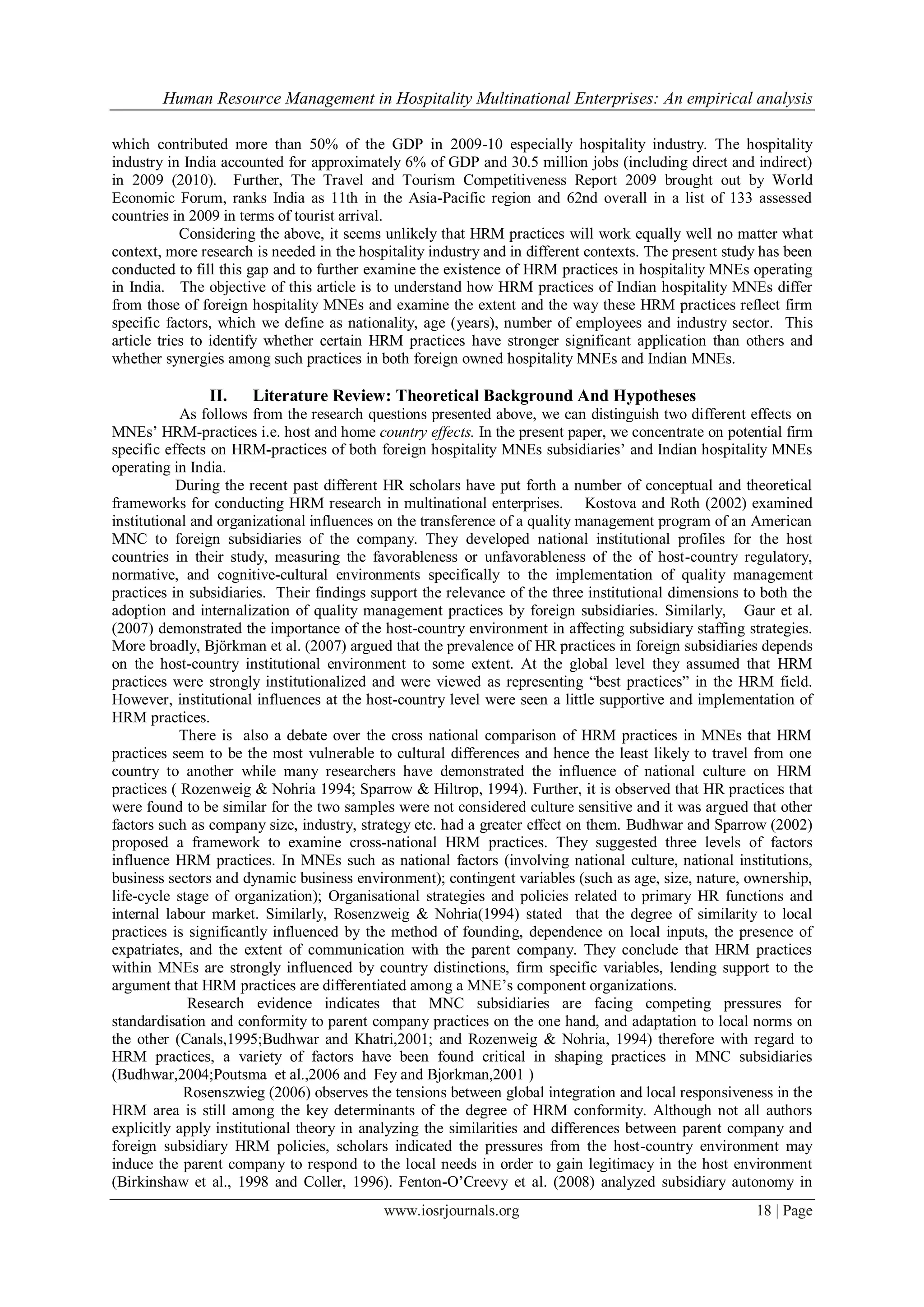
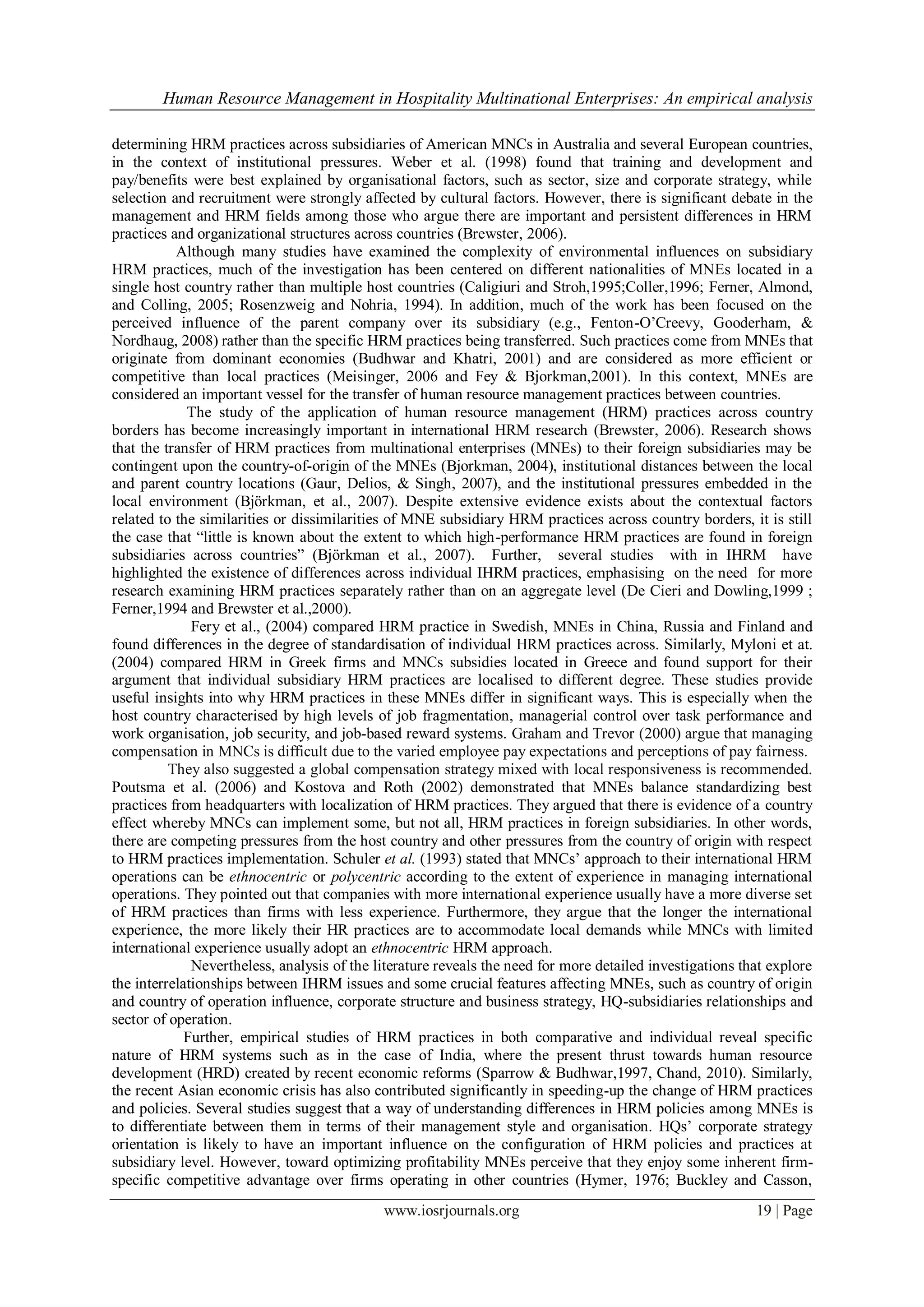
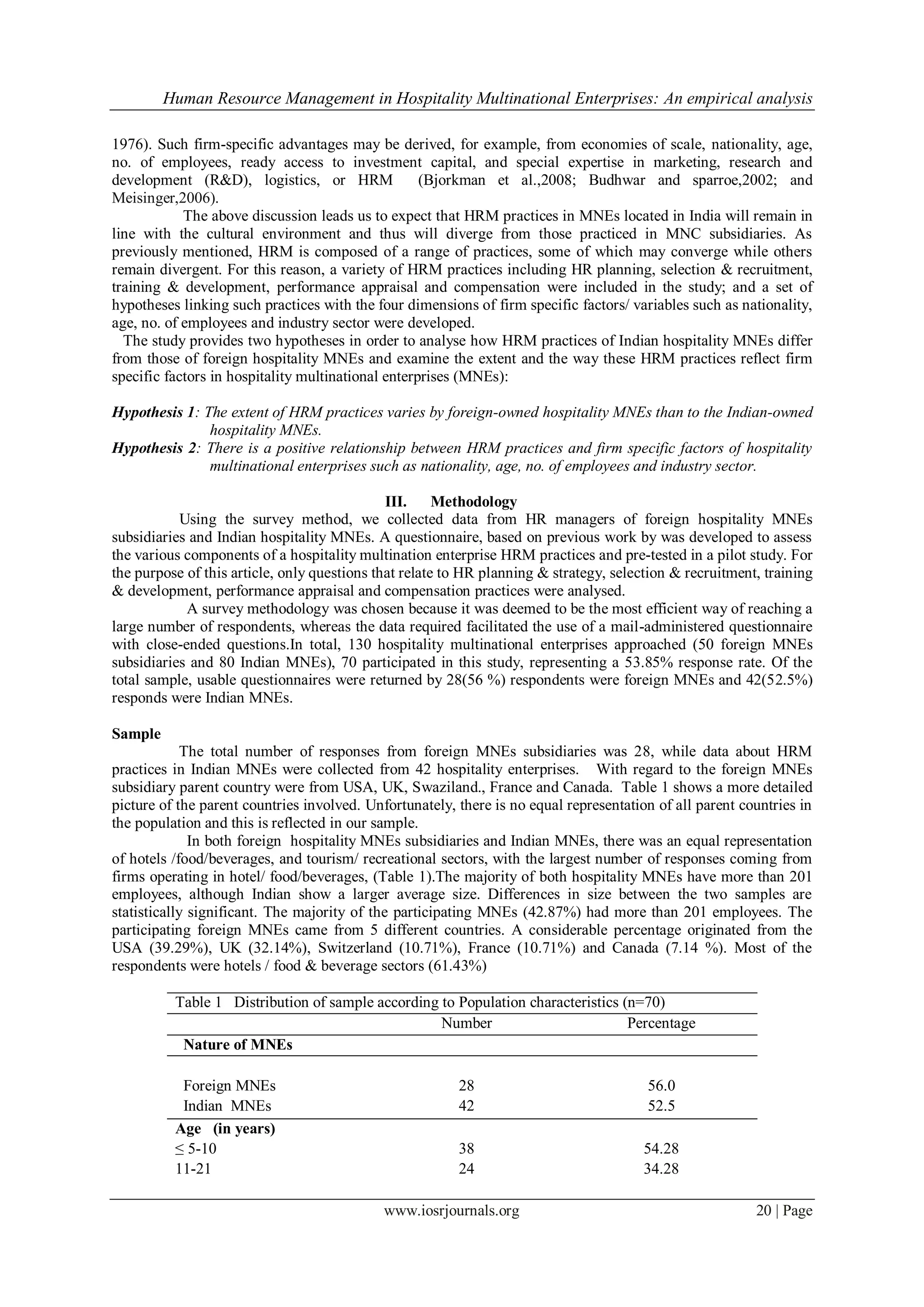

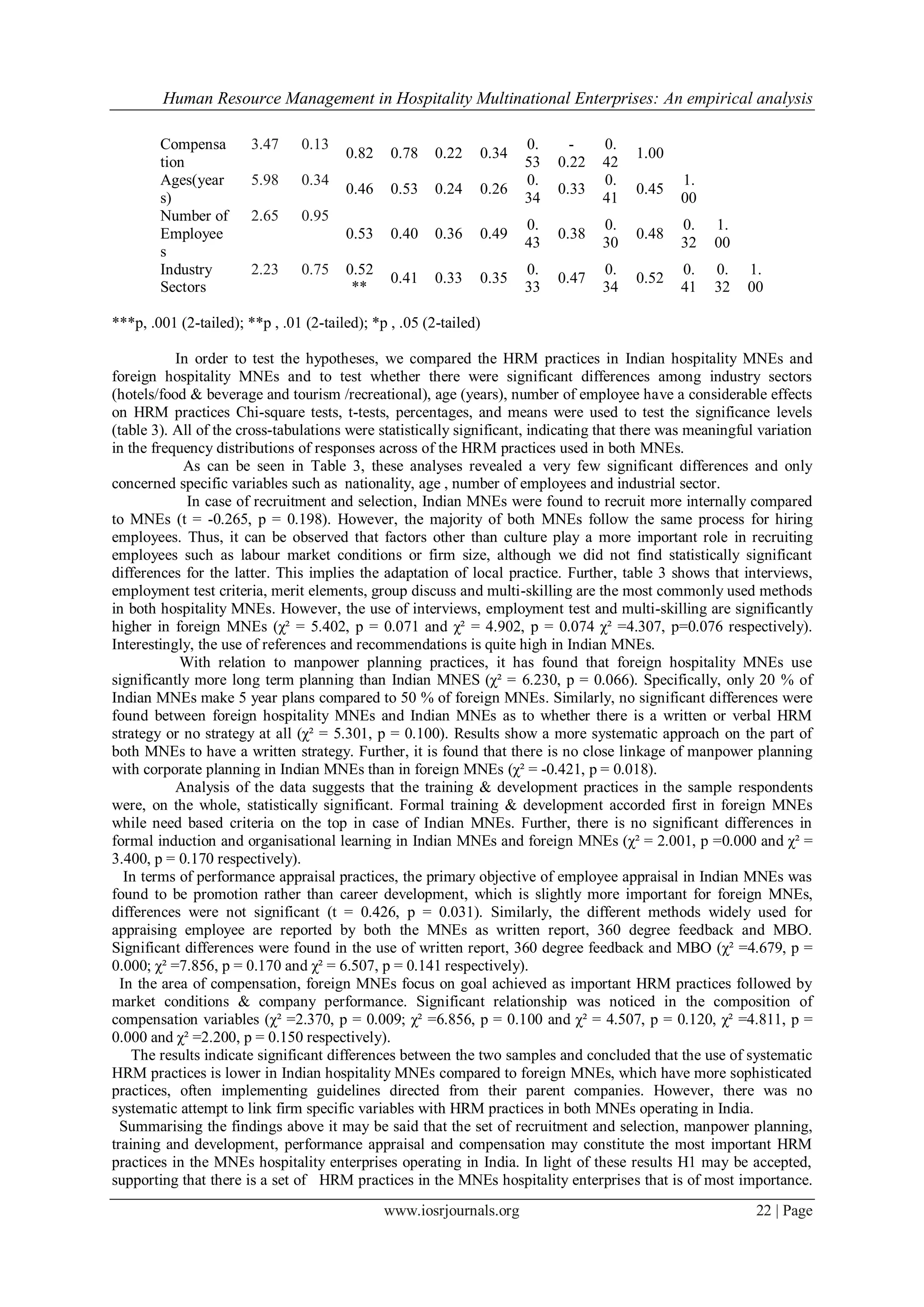

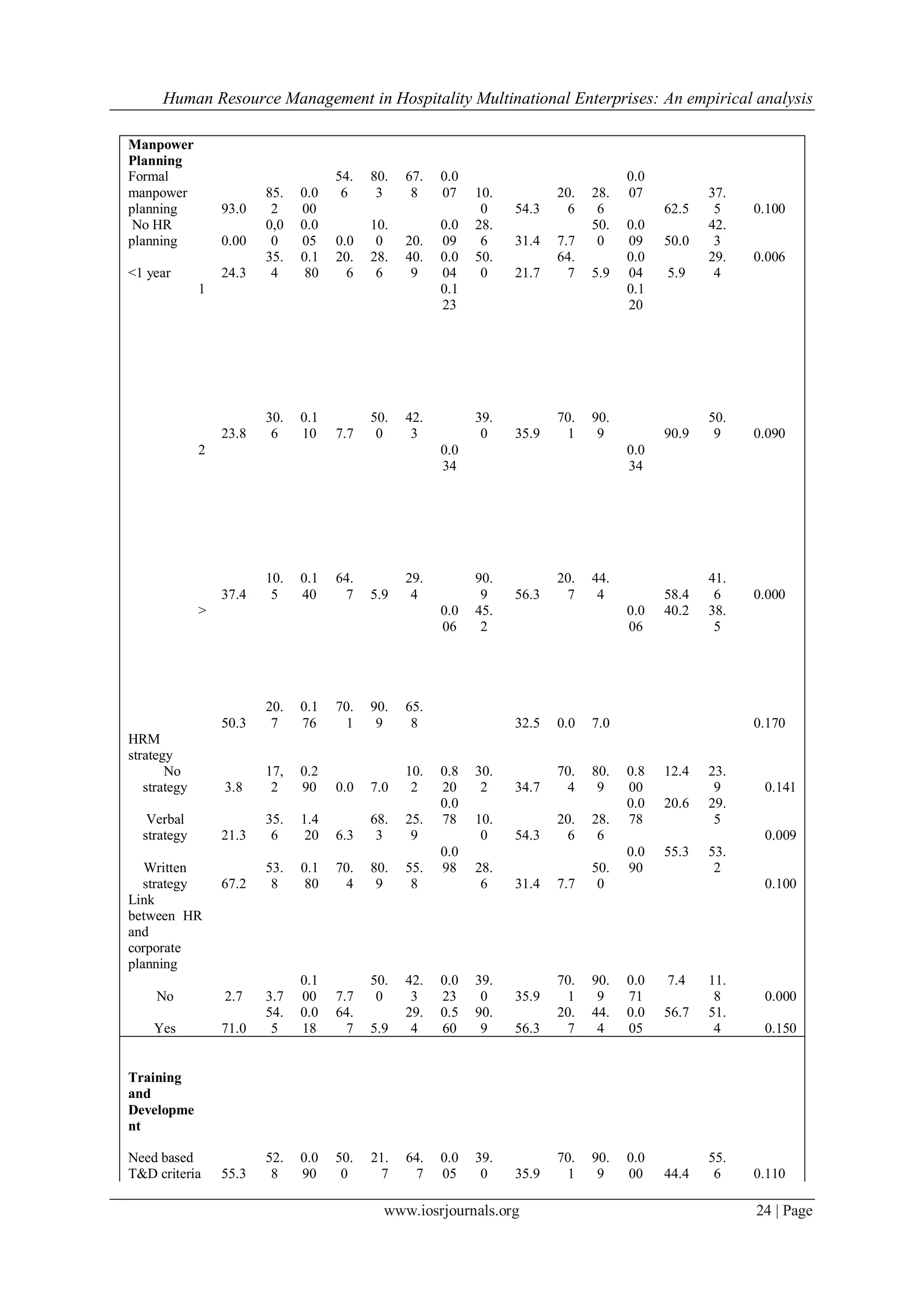
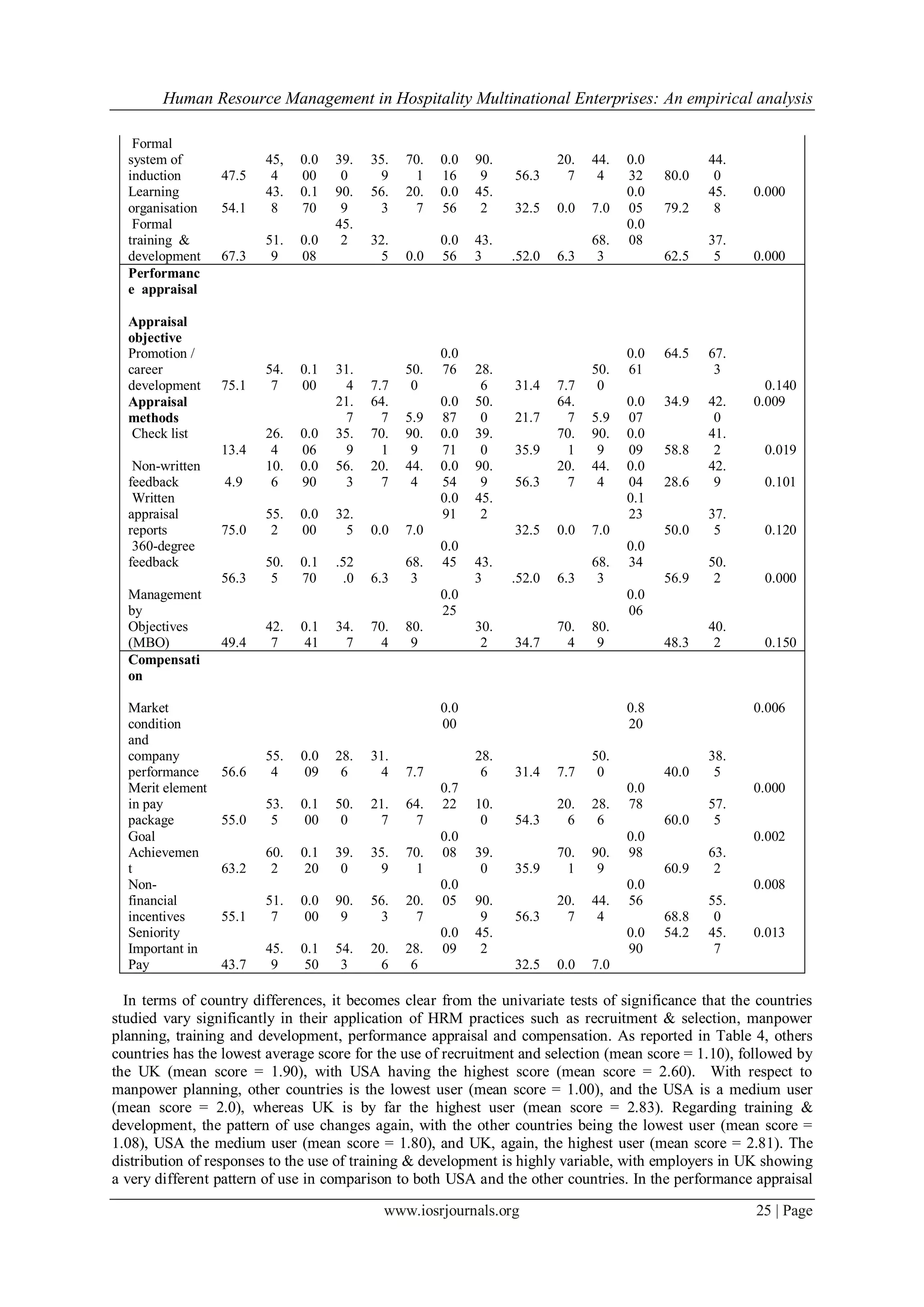
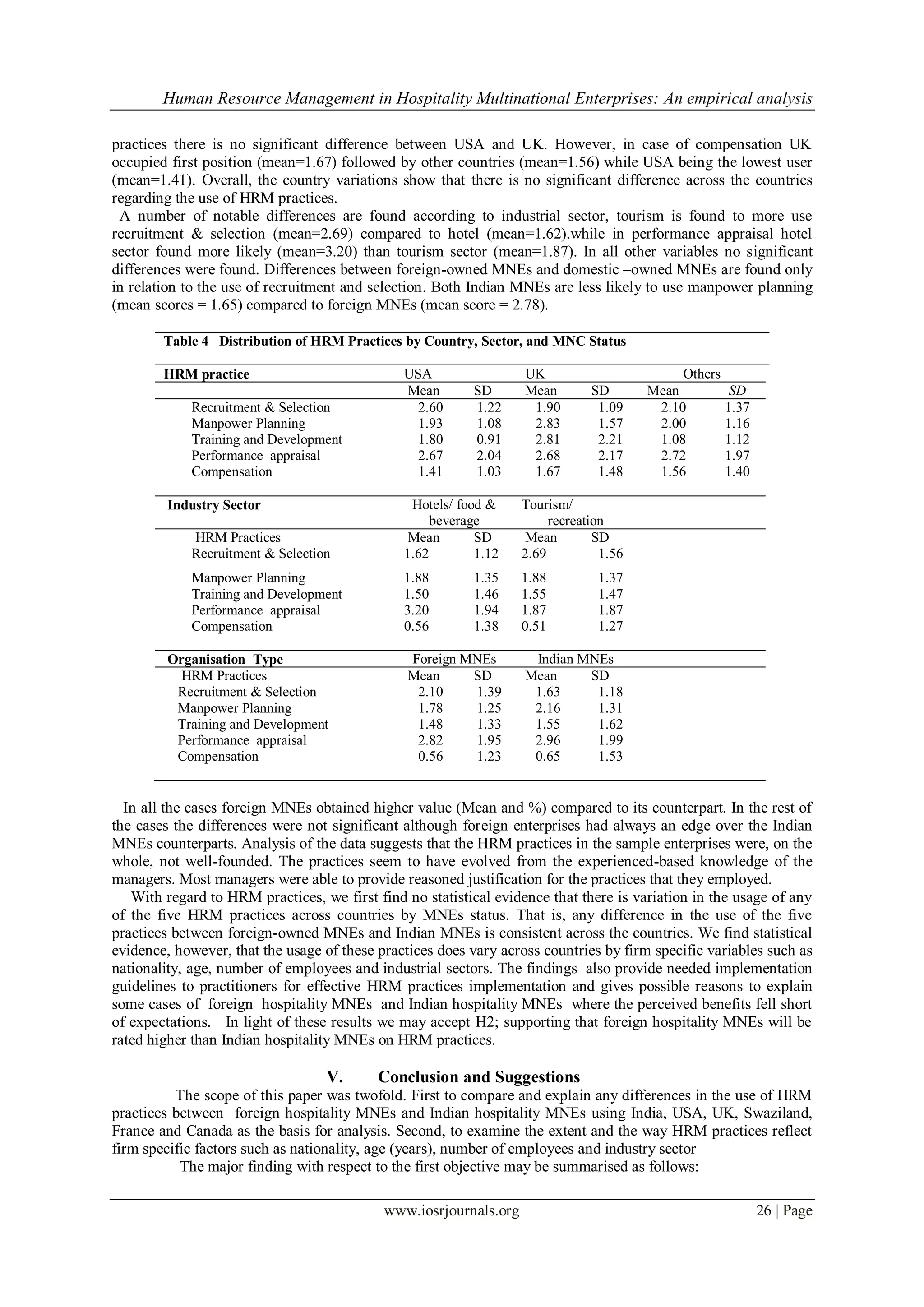
![Human Resource Management in Hospitality Multinational Enterprises: An empirical analysis
www.iosrjournals.org 27 | Page
Although the use of flexibility HRM practices appears to be increasing in response to global competitive
pressures and market uncertainty, the study shows that they are not deployed to the same extent across countries,
nor appreciably more so by foreign hospitality MNEs than by Indian hospitality MNEs. Moreover, MNEs are
not attempting to diffuse or impose HRM practices on their workforces in host countries or they have been
constrained from doing so, because of huge cost or limited benefits of host location.
The major finding with respect to the second objective may be summarised as follows: HRM
practices are positively related with firm specific factors. It would appear, therefore, that the effects of
nationality, age, number of employee and industrial sector substantially moderate the actions of MNEs. No
doubt, host country is the dominant influence on the deployment of HRM practices in MNEs. However, the
evidence here would suggest that the diffusion of HRM practices is heavily influenced by firm specific factors
that play a significant role in shaping organizational responses and, in turn, the adoption of HR practices. The
research confirms that there is a clear evidence of a „nationality‟ effect on HRM practices. This study also
confirms that an age effect is less dominant than industrial effect in hospitality MNEs. The international HRM
practices should be considered carefully. It would be better to say, the HRM systems in the organization
depends on the composition of the top management.
References
[1]. Birkinshaw, J. M.; Hood, N. and Jonsson, S. (1998) Building firm-specific advantages in multinational corporations: The role of
subsidiary initiative, Strategic Management Journal, 19, 221-241.
[2]. Bjorkman, I. (2004) Transfer of HRM to MNC affiliates in Asia Pacific. In P. Budhwar (Ed.) Managing Human Resources in Asia-
Pacific. London: Routledge.
[3]. Bjorkman, I., Budhwar, P., Smale, A., & Sumelius, J. (2008). Human resource management in foreign owned subsidiaries: China
versus India. International Journal of Human Resource Management, 19(5), 964–978.
[4]. Björkman, I., Fey, C.F., & P ark, H. J. (2007). Institutional theory and MNC subsidiariy HRM practices: evidence from a three-
country study. Journal of International Business Studies, 38: 430-446.
[5]. Brewster, C. (2006). Comparing HRM policies and practices across international borders. In G. Stahl & I. Björkman (eds),
Handbook of international human resource management (pp. 68-90). Cheltenham, UK: Edward Elgar Fenton-O‟Creevy, M.,
Gooderman, P., & Ohldnordbaug, O. (2008). Human resource management in US subsidiaries in Europe and Australia, Journal of
International Business Studies, 39: 151-166.
[6]. Brewster, C., Tregaskis, O., Hegewisch, A. and Mayne, L. (2000). "Comparative Research in Human Resource Management: A
Review and an Example." In Brewster, C., Mayrhofer, W., and Morley, M. (eds.), New Challenges for European Human Resource
Managemen. London: Macmillan, pp. 324–48.
[7]. Buckley, P. J. and Casson, M. C. (1976). The Future of the Multinational Enterprise.London: Macmillan.
[8]. Budhwar P.S. and Sparrow P.R.(2002) An integrative framework for understanding cross-national human resource management
practices, Human Resource Management Review ,12,PP. 377–403.
[9]. Budhwar, P. (2004) Introduction: HRM in the Asia-Pacific Context. In P. Budhwar (Ed.) Managing Human Resources in Asia-
Pacific. London: Routledge, 1-15.
[10]. Budhwar, P., & Khatri, N. (2001). Comparative human resource management in Britain and India: an empirical study. International
Journal of Human Resource Management, 13(5), 800–826.
[11]. Budhwar, P., & Khatri, N. (2001). Comparative human resource management in Britain and India: an empirical study. International
Journal of Human Resource Management, 13(5), 800–826.
[12]. Caligiuri, P. and Stroh, L. (1995). “Multinational Corporation Management Strategies and International Human Resources
Practices: Bringing IHRM to the Bottom Line.” The International Journal of Human Resource Management 5 (5), pp. 494–504.
[13]. Canals, J. (1995) Country-, Industry- and Firm-Specific Factors in Global Competition, in Thomas, H.; O‟Neal, D. and Kelly, J.
(eds.), Strategic Renaissance and Business Transformation, Chicester: John Wiley and Sons, 107-133.
[14]. Chand, M. (2010). Human resource management practices in Indian hospitality enterprises: an empirical analysis, Managing
Leisure, 15(1),4-16.
[15]. Coller, X. (1996) Managing Flexibility in the Food Industry: A Cross-national Comparative Case Study in European Multinational
Companies, European Journal of Industrial Relations, 2, 2,153-172.
[16]. De Cieri, H. and Dowling, P. J. (1999). “Strategic Human Resource Management in Multinational Enterprises: Theoretical and
Empirical Developments.” Research in Personnel and Human Resources Management, Supplement 4, pp. 305–27.
[17]. Fenton-O‟Creevy, M., Gooderman, P., & Ohldnordbaug, O. (2008). Human resource management in US subsidiaries in Europe and
Australia, Journal of International Business Studies, 39: 151-166.
[18]. Ferner, A. (1994) Multinationals Companies and Human Resource Management: An Overview sof Research Issues, Human
Resource Management Journal, 4, 3, 79-102.
[19]. Ferner, A. (1997). “Country of Origin Effects and HRM in Multinational Companies.” Human Resource Management Journal 7
(1), pp. 19–37.
[20]. Ferner, A., & Quintanilla, J. (1998). Multinationals, national business systems, and HRM: The enduring influence of national
identity. International Journal of Human Resource Management, 9(4): 710-731.
[21]. Ferner, A., Almond, P., & Colling, T. (2005). Institutional theory and the cross-national transfer of employment policy: the case of
„workforce diversity‟ in US multinationals. Journal of International Business Studies, 36: 304-321.
[22]. Fey, C., & Björkman, I. (2001). The effect of human resource management practices on MNC subsidiary performance in Russia.
Journal of International Business Studies, 32(1): 59-75.
[23]. Gaur, A. S., Delios, A., & Singh, K. (2007). Institutional environments, staffing strategies, and subsidiary performance. Journal of
Management, 33 (4), 611-636.
[24]. Government of India (2006) Investing in India: Foreign Direct Investment, Policies andProcedures, Ministry of Commerce and
Industry, Department of Industrial Policy and Promotion.
[25]. Graham, M. E., & Trevor, C. O. (2000). Managing new pay program introduction to enhance the competitiveness of multinational
corporations (MNCS). Competitiveness Review, 10(1), 136–154.](https://image.slidesharecdn.com/c01041728-150430043351-conversion-gate01/75/Human-Resource-Management-in-Hospitality-Multinational-Enterprises-An-Empirical-Analysis-11-2048.jpg)
![Human Resource Management in Hospitality Multinational Enterprises: An empirical analysis
www.iosrjournals.org 28 | Page
[26]. Hiltrop J M (1999) The use of HRM practices in international and domestic organizations, New Zealand Journal of Industrial
Relations, Vol.24, Issue 1, P.47-61.
[27]. Hymer, S. (1976). The International Operations of National Firms. Cambridge, Mass MIT Press.
[28]. Kostova, T., & Roth, K. (2002). Adoption of an organizational practice by subsidiaries of multinational corporations: Institutional
and relational effects. Academy of Management Journal, 45(1): 215-233.
[29]. Kostova, T., & Roth, K. (2002). Adoption of an organizational practice by subsidiaries of multinational corporations: Institutional
and relational effects. Academy of Management Journal, 45(1), 215–233.
[30]. Meisinger, S. R. (2006). Global workforce issues: Challenge and opportunity. HR Magazine, 51(1), 10.
[31]. Ministry of Tourism, Govt. of India (2010). Tourism statistics –report, New Delhi.
[32]. Mohinder C. (2010). Human resource management practices in Indian hospitality enterprises: an empirical analysis, Managing
Leisure, 15(1),4-16.
[33]. Myloni, B., Harzing, A.W.K. and Mirza, H. (2004). Host country specific factors and the transfer of human resource management
practices in multinational companies.International Journal of Manpower, 25 (6), 518-534.
[34]. Poutsma, E., Ligthart, P. E. M., & Veersma, U. (2006). The diffusion of calculative and collaborative HRM practices in European
firms. Industrial Relations, 45(4), 513–546.
[35]. Rosenzweig, P. & Nohria, N. (1994). Influences on human resource management practices in multinational corporations. Journal of
International Business Studies, 25(2): 229-251.
[36]. Schuler, R. S.; Dowling, P. J. and De Cieri, H. (1993) An integrative framework of strategic international human resource
management, The International Journal of Human Resource Management, 4, 4, 717-764.
[37]. Sparrow P, Brewster C and Harris H (2004) Globalizing human resource management, London, Routledge.
[38]. Vachani, S. (2008) „India: opportunities and challenges for multinational enterprises‟, Int. J. Business and Emerging Markets, Vol.
1, No. 1, pp.42–60.
[39]. World Travel and Tourism Council (WTTC), (2010), Statistical Report on Tourism, United Kingdom.Zainulbhai Adil S., (2007)
“Securing India‟s place in the global economy”, The Mckinsey Quarterly, 2007 special edition, page 10.](https://image.slidesharecdn.com/c01041728-150430043351-conversion-gate01/75/Human-Resource-Management-in-Hospitality-Multinational-Enterprises-An-Empirical-Analysis-12-2048.jpg)